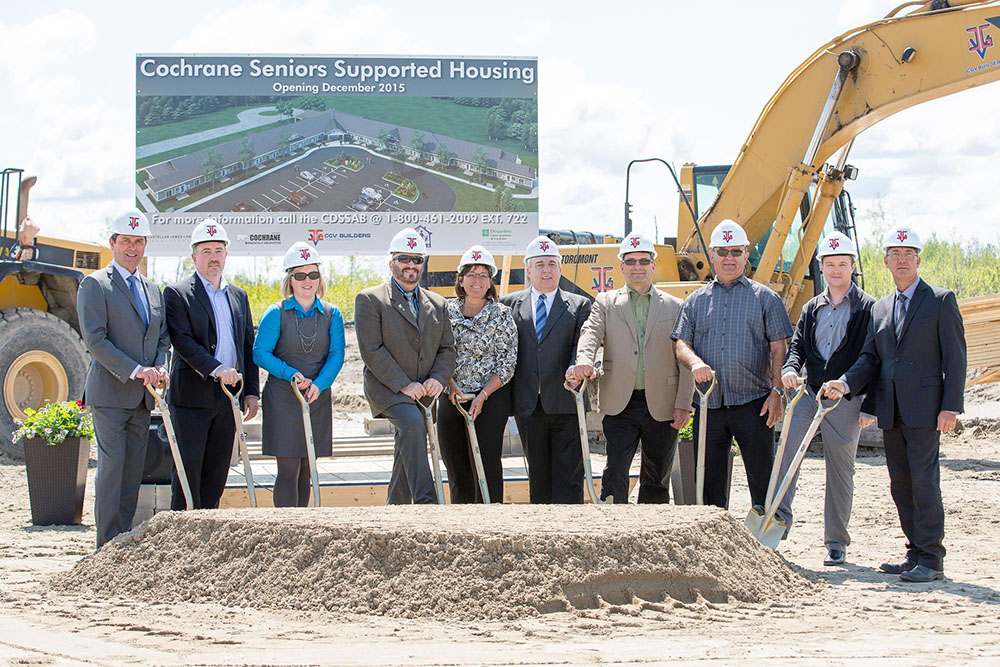Enhancing Lives Through Government-Corporate Collaborations
By Rajitha Sivakumaran
 Late July of this year marked the official opening of the Cochrane Retirement Living Complex by the Cochrane District Social Services Administration Board (CDSSAB). Courtesy of the CDSSAB, the town of Cochrane and CGV Builders, this 29,300-square-foot facility offers seniors independent, affordable living in a nurturing and social environment.
Late July of this year marked the official opening of the Cochrane Retirement Living Complex by the Cochrane District Social Services Administration Board (CDSSAB). Courtesy of the CDSSAB, the town of Cochrane and CGV Builders, this 29,300-square-foot facility offers seniors independent, affordable living in a nurturing and social environment.
The story behind the building is a tale of a communal need, untapped markets, deficient funds and government-corporate collaboration.
Located in Northeastern Ontario, the Cochrane District occupies about 14 per cent of the province’s landmass. Approximately 85,000 residents live in the area adjacent to the Quebec border and James Bay. Nearly half the population is Francophone, but there is a large and growing Indigenous population as well. The average age in the Cochrane District is slightly over the provincial average (42 years), making it a population that is aging at a quicker pace than the rest of Ontario. The out-migration of young people from this region is only exacerbating this dilemma.
The CDSSAB was formed in 1999 to deliver government-funded social services, such as Ontario Works, children’s services, emergency medical services and housing, to various municipalities within the Cochrane District. With an operating budget of about $63 million annually, the CDSSAB delivers services from seven offices and a series of ambulance bases throughout the district. It is the biggest landlord in the area too, which is why it was able to see the gaps in housing infrastructure.
Two years ago, the CDSSAB carried out a series of public consultations in all the communities it serves in order to develop a 10-year housing plan. One of the key pieces of information obtained was the significant need for senior supportive housing. The main drivers here were seniors who did not want to leave Northern Ontario, but could no longer live on their own. There was a gap in rental housing that fit the needs of the aging population, and that sparked plans for a new assisted-living facility. The problem, however, was securing funds.
“When a Private Public Partnership opportunity arose in a thriving Northern Ontario community, we embraced the opportunity to create affordable senior supportive housing, which is a new business venture for public housing,” said David Landers, the CDSSAB’s chief administrative officer.
That was when local developers, CGV Builders, entered the picture. Having participated in many of these consultations, the company pitched the idea of working collaboratively on the project. Profit was not the focus of this project for the CDSSAB, said Landers. Rather, it was getting the project off paper and into brick-and-mortar reality in order to address the gap in senior housing. Nonetheless, the building needed to be constructed as efficiently as possible in order to meet operating costs afterwards.
“What we’ve done is try to work on projects that meet local needs that are also financially sustainable,” Landers said. Since the municipalities have little funds to devote to social and housing services, approaching new projects using a business model is especially important. Such a model had already worked successfully when the CDSSAB built housing for at-risk individuals experiencing and/or fleeing from domestic violence in Timmins. That facility was built in a way that leveraged assets to bring down costs so that the housing itself would be affordable without being subsidized by the municipality.
In this case, CGV Builders put up the capital cost associated with construction of the facility, after which point the CDSSAB purchased it, using the best financing they could find. Through Toronto Dominion Commercial Lending, that was made possible.
“This project would not have happened without CGV Builders,” Landers said. “They had a great vision, they listened to the community, they spoke with us and they helped us build a financial model that would ensure that we could do this.”
In addition to creating 32 affordable supportive housing units, the initiative resulted in 14 full-time and part-time jobs.
With the completion of this project, the CDSSAB once again lived up to its mandate of being responsive to community needs. As an all-inclusive facility, residents receive three meals a day with access to medical services (like prescription medicine reminders), light housekeeping and bed linen laundry, and daily recreational activities. With rental prices starting at $1,390, seniors are the ones profiting from this initiative. Seventy-five per cent of units were occupied within 10 months of opening. By the time the facility’s one-year anniversary arrives, an 80-90 percent occupancy rate is expected.
The average age of seniors residing in the facility is 85 years. “We are dealing with a very senior age group and with that group comes the need for a lot of support services, which are not always available,” Landers said. “While there are a lot of home care services available, we’ve identified gaps and we’ve basically targeted a lot of those gaps.” The services offered provide a better quality of life for seniors, like easier access to healthcare professionals such as physiotherapists and recreational therapists.
Through what Landers called community paramedicine, residents get the medical support they need before they enter primary care with a doctor or hospital; since the CDSSAB is in charge of ambulance services, tenants can regularly consult with on-site paramedics. The result is a smaller likelihood of hospitalization and longer life expectancy.
“We have also put a significant focus on the socialization of the individual,” Landers added, explaining that some tenants had been living on their own with little social contact prior to move-in. “One thing that we know is that the more socially isolated people are in a community, the lower their health will be. So working towards creating a sense of community in the building is important.”
Being a mandate-driven organization, the CDSSAB’s work is far from done. Presently, the organization is working with the Housing Services Corporation to develop a housing bank in Canada. In the UK, housing authorities are able to access low-cost loans and mortgages through the national housing bank, whose mandate is to provide financial expertise and funds for housing developments throughout the country. Accordingly, affordable housing equates with big business over there, but here in Canada that is not the case.
“It would be very helpful for non-profit housing providers in Canada,” Landers said, adding that this is something that is already of interest to the provinces of Ontario and British Columbia.
www.cdssab.on.ca






